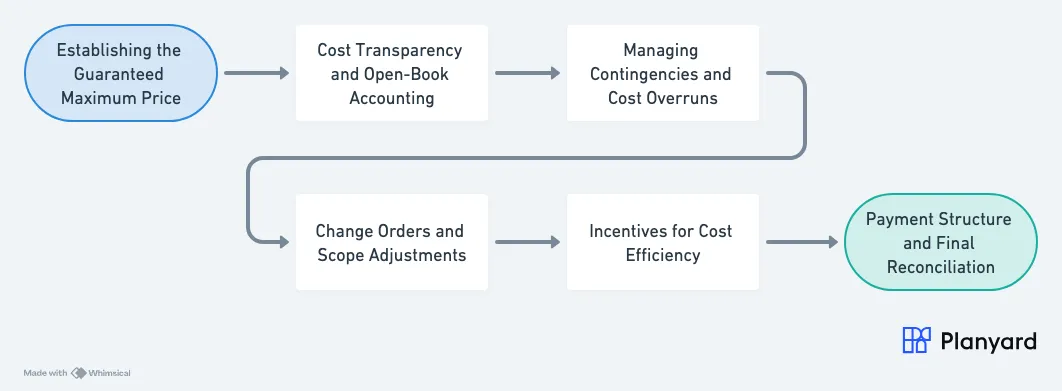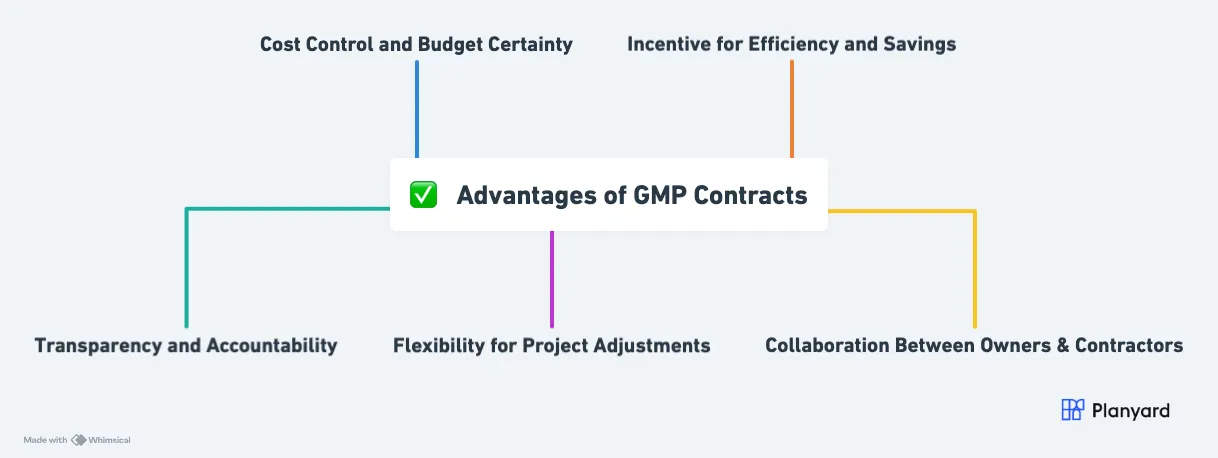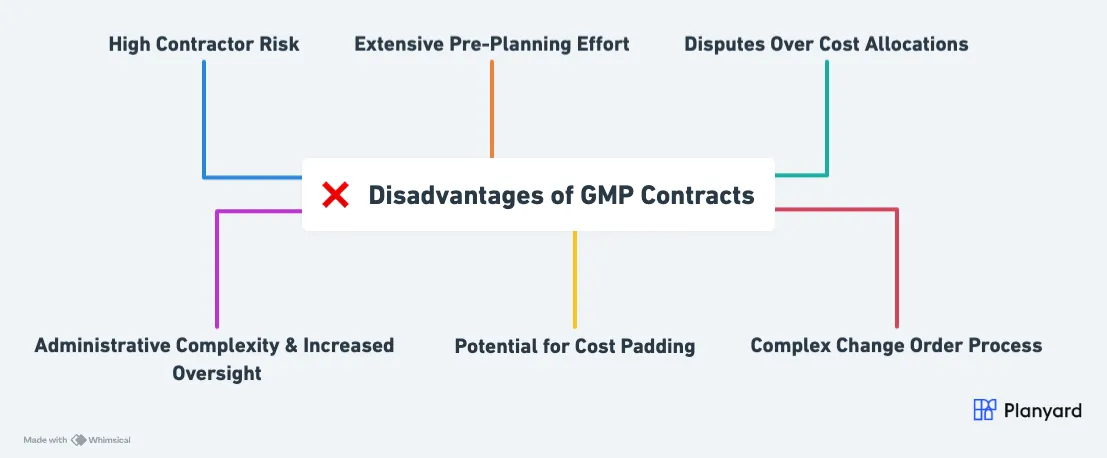A Guaranteed Maximum Price (GMP) contract is a construction agreement where the contractor commits to completing a project for a price that will not exceed a predetermined maximum. If costs exceed this cap, the contractor is responsible for covering the overage, unless changes are made to the project scope. This type of contract provides cost certainty for project owners while placing financial risk on contractors.
What Does GMP Stand for in Contracting?
GMP stands for Guaranteed Maximum Price, a widely used contract type in construction and contracting. Under a GMP contract, the contractor agrees to complete a project for a fixed maximum price, ensuring that the total cost does not exceed the agreed-upon budget unless scope changes occur.
This type of contract provides cost certainty for project owners, as they know the maximum financial commitment required before construction begins. At the same time, it places financial risk on the contractor, who must cover any cost overruns unless they are due to approved change orders.
GMP contracts are commonly used in large-scale commercial, infrastructure, and institutional projects, where budget predictability, cost transparency, and financial control are essential. Unlike lump-sum contracts, which offer a single fixed price, GMP agreements allow for cost tracking and adjustments within the contract’s budget framework, giving both owners and contractors greater flexibility in managing expenses.
How Does a GMP Contract Work?
A Guaranteed Maximum Price (GMP) contract operates as a structured agreement between a project owner and a contractor, ensuring that the project is completed within a set financial limit. It is designed to offer cost certainty to the owner while placing the financial risk of cost overruns on the contractor. Understanding how a GMP contract works requires looking at its key components, the responsibilities of each party, and the financial mechanisms that ensure compliance.
1. Establishing the Guaranteed Maximum Price
Before signing a GMP contract, both parties go through an extensive pre-construction phase to define the project scope, estimate costs, and determine a realistic maximum price. This process includes:
- Cost Estimation: The contractor prepares a detailed estimate, breaking down costs for labor, materials, equipment, subcontractors, and indirect expenses.
- Contingency Allocation: A portion of the budget is set aside for unexpected costs, but how and when these funds can be used is usually specified in the contract.
- Fee Structure: The contractor’s profit and overhead costs are defined, typically as a fixed fee or a percentage of total costs.
Once all these details are finalized, the contract is signed, locking in the GMP and establishing a financial framework for the project.
2. Cost Transparency and Open-Book Accounting
One of the key characteristics of a GMP contract is cost transparency. Unlike lump-sum contracts where the owner only sees the total price, GMP contracts allow owners to review and track actual costs.
- The contractor maintains detailed cost records, including invoices, purchase orders, and labor costs.
- The owner has the right to audit project expenses to ensure funds are being used appropriately.
- Some contracts allow for shared savings, where any unused budget is split between the contractor and owner.
This open-book approach fosters trust and ensures that cost savings benefit both parties rather than only the contractor.
3. Managing Contingencies and Cost Overruns
A GMP contract includes a contingency fund to cover unexpected costs such as material price fluctuations, weather-related delays, or minor design changes. However, how this fund is used depends on the contract terms:
- In some cases, the contractor controls the contingency and decides how to allocate it.
- Other contracts require owner approval before contingency funds are used.
- If expenses exceed the GMP without a valid change order, the contractor must cover the overages.
This system ensures that cost overruns do not impact the project owner’s budget, making it an attractive option for large-scale construction projects.
4. Change Orders and Scope Adjustments
While a GMP contract sets a maximum price, it does allow for modifications through change orders. These changes can occur due to:
- Owner-driven modifications (e.g., upgrading materials, expanding the project scope).
- Unforeseen site conditions (e.g., discovering unstable soil requiring additional foundation work).
- Regulatory or code compliance updates that were not initially accounted for.
When a change order is requested, the contractor must provide a revised cost estimate and seek approval before proceeding. This process ensures that new expenses are properly documented and do not violate the GMP terms.
5. Incentives for Cost Efficiency
Since contractors bear the financial risk of exceeding the GMP, they are highly motivated to manage costs efficiently. This often leads to:
- More accurate procurement planning to secure materials at the best price.
- Better labor and subcontractor management to prevent delays and inefficiencies.
- Stronger project coordination to reduce downtime and avoid costly errors.
In some contracts, owners offer an incentive bonus if the contractor completes the project below budget. This structure encourages both cost control and high-quality performance.
6. Payment Structure and Final Reconciliation
Payments in a GMP contract are typically made through a progress billing system, where the contractor submits invoices at predefined milestones. Payments may include:
- Reimbursements for actual costs incurred.
- Scheduled contractor fees.
- Allowances for contingency usage (if applicable).
At project completion, the final cost reconciliation takes place. If costs are lower than the GMP, savings are either returned to the owner or split according to the contract terms. If costs exceed the GMP, the contractor absorbs the additional expenses unless a change order was approved.

GMP vs. Lump-Sum Contracts: Key Differences
When selecting a contract type for a construction project, understanding the differences between Guaranteed Maximum Price (GMP) contracts and lump-sum contracts is crucial. While both aim to define project costs upfront, they vary in cost structure, risk allocation, and financial transparency.
GMP contracts offer cost flexibility and transparency, while lump-sum contracts provide fixed pricing with minimal owner involvement in cost management. Below, we break down the key differences to help project owners and contractors choose the right approach for their needs.
| Feature | GMP Contract | Lump-Sum Contract |
|---|---|---|
| Cost Certainty | Ensures a maximum price but allows flexibility within budget. | A fixed price is agreed upon, with minimal adjustments. |
| Risk Allocation | The contractor bears the risk if costs exceed the GMP. | The contractor carries all cost risks unless a change order is issued. |
| Transparency | Owners can see cost breakdowns and potential savings. | Limited cost breakdown; owners know only the total amount. |
| Flexibility | Adjustments are possible within the budget framework. | Changes require formal change orders, often leading to cost increases. |
Advantages of GMP Contracts
Cost Control and Budget Certainty
One of the biggest advantages of a GMP contract is that it establishes a clear cost ceiling, giving project owners confidence that the total cost will not exceed the agreed-upon amount. This predictability helps owners secure financing more easily, reduces the likelihood of unexpected budget overruns, and ensures that projects remain financially viable. Unlike other contract types where costs can spiral due to change orders and unforeseen issues, GMP contracts provide a structured approach to managing expenses.
Incentive for Efficiency and Cost Savings
Because contractors bear the risk of exceeding the guaranteed maximum price, they are highly motivated to control costs, reduce waste, and manage resources effectively. This often leads to better project planning, more efficient procurement of materials, and a well-structured construction process that minimizes delays. Additionally, in some GMP agreements, any cost savings achieved are shared between the contractor and owner, further encouraging the contractor to work efficiently while benefiting both parties.
Greater Transparency and Accountability
Unlike lump-sum contracts where owners only see the final price, GMP contracts break down costs into detailed components, including labor, materials, and overhead. This level of transparency allows owners to review and approve expenses, ensuring that their money is being spent wisely. Owners can also see how contingency funds are used and make informed decisions about budget adjustments. Additionally, since contractors must justify their expenditures, GMP contracts reduce the risk of inflated costs and hidden fees.
Flexibility for Project Adjustments
GMP contracts allow for modifications within the set price, providing some flexibility for minor adjustments without the need for constant renegotiation. If unexpected challenges arise—such as material shortages or design changes—the project owner and contractor can reallocate funds within the GMP framework, preventing unnecessary delays or disputes. This is particularly useful for large-scale projects where unforeseen issues are common, as it enables quick decision-making without exceeding the overall budget.
Since both parties benefit from efficient cost management, GMP contracts foster a collaborative working relationship. Contractors are incentivized to communicate openly with owners, ensuring transparency and alignment on financial matters. This structure reduces adversarial disputes that are common in other contract types, where owners may feel that contractors are overcharging or inflating costs. With a GMP contract, both sides work towards a mutual goal of completing the project within budget while maintaining quality standards.

Disadvantages of GMP Contracts
High Contractor Risk and Financial Pressure
One of the biggest drawbacks of a GMP contract is the significant financial risk placed on the contractor. If actual construction costs exceed the agreed-upon guaranteed maximum price, the contractor must absorb the additional expenses, cutting into their profits. This financial pressure can lead to tighter cost controls, but it may also result in cost-cutting measures that could impact quality, such as using lower-grade materials or reducing labor hours. Smaller contractors, in particular, may struggle with cash flow issues if they are forced to cover unexpected cost overruns.
Extensive Pre-Planning and Estimating Effort
For a GMP contract to be effective, a highly detailed cost estimate must be developed before work begins. This requires accurate forecasting of material costs, labor expenses, and potential contingencies—a process that can be time-consuming and complex. The pre-construction phase involves extensive collaboration between owners, designers, and contractors to define project scope and potential risks. If estimates are inaccurate or incomplete, it could lead to disputes, financial losses, or project delays.
Disputes Over Cost Allocations and Contingency Usage
Although GMP contracts promote transparency, they can also lead to disagreements over cost allocations. Owners may question whether certain expenses—such as administrative overhead, labor inefficiencies, or subcontractor delays—should be covered by the contractor or classified as legitimate project costs. Additionally, many GMP contracts include a contingency fund, but disputes may arise over who controls it and how it is used. If owners and contractors disagree on what constitutes an unforeseen expense, it could strain the working relationship and slow down the project.
Administrative Complexity and Increased Oversight
Unlike lump-sum contracts where the contractor simply delivers the project for a set price, GMP contracts require ongoing financial tracking, documentation, and approvals. Contractors must carefully document expenses, submit cost reports, and justify their spending, which increases administrative workload. Project owners must also dedicate resources to reviewing financial reports, approving expenditures, and tracking cost allocations. This level of oversight can slow down decision-making and add to project management costs.
Potential for Cost Padding or Over-Conservatism
Since contractors bear the risk of overruns, they may inflate their initial GMP estimate to create a financial cushion. While this protects them from unexpected expenses, it may also result in higher project costs for the owner than necessary. Contractors might also be overly conservative when allocating contingency funds, limiting their flexibility to adjust for minor changes or efficiencies. In some cases, this can lead to higher upfront project bids compared to other contract types.
Even though GMP contracts allow for some flexibility within the budget, significant changes—such as scope modifications, design alterations, or regulatory adjustments—require formal change orders. This can be a slow and bureaucratic process, involving new cost estimates, contract amendments, and extended negotiations. If the project experiences frequent changes, these delays can impact the construction timeline and create frustration for all parties involved.

How GMP Contracts Fit into Construction Budgeting
For construction teams seeking real-time cost control, budget forecasting, and streamlined contract management, Planyard offers a solution that integrates GMP contracts seamlessly. Planyard helps with:
- Tracking project budgets and commitments in real time.
- Managing change orders efficiently to reflect cost adjustments.
- Automating cost allocation to reduce errors and improve financial oversight.
By replacing spreadsheets with Planyard’s construction budgeting software, teams can ensure cost transparency, minimize financial risks, and improve project profitability.
Managing GMP Contract Challenges with Technology
To overcome these disadvantages, construction teams can use financial tracking and budget management tools like Planyard. By integrating real-time cost monitoring, automated cost tracking, and efficient change order management, Planyard helps contractors and project owners maintain financial control and transparency throughout the project lifecycle.
By leveraging the right tools, construction teams can minimize financial risks, streamline contract administration, and ensure that GMP contracts work to their advantage.
Conclusion
A GMP contract is a powerful tool for ensuring cost control in construction projects. However, it requires detailed planning, effective risk management, and robust financial oversight. With tools like Planyard, construction teams can enhance budget tracking, streamline contract management, and gain real-time insights into project costs, ensuring that GMP contracts deliver the best value for both owners and contractors.
